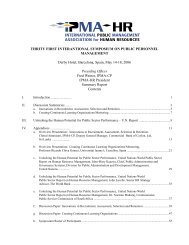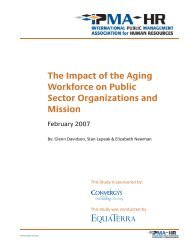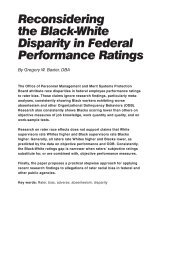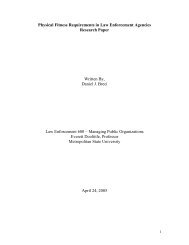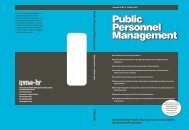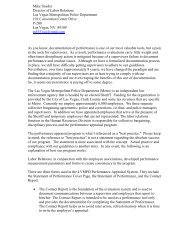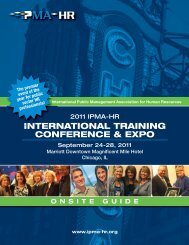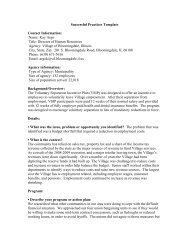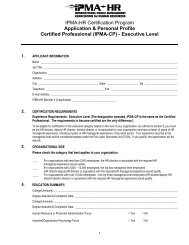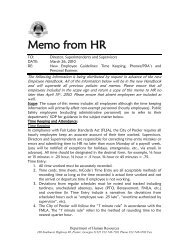July 2011 issue of HR News magazine - IPMA
July 2011 issue of HR News magazine - IPMA
July 2011 issue of HR News magazine - IPMA
Create successful ePaper yourself
Turn your PDF publications into a flip-book with our unique Google optimized e-Paper software.
■ l a b o r - m a n a g e m e n t c o o p e r a t i o n & n e g o t i a t i n g w i t h u n i o n s ■<br />
Unionism CONTINUED<br />
FROM PAGE 7<br />
New Jersey is a highly unionized state, it was inevitable that public<br />
employees in massive numbers would seize the opportunity to<br />
organize and engage in the collective negotiations process.<br />
During the past 40 years, both in New Jersey and throughout the<br />
nation, there has been an explosion <strong>of</strong> public employee membership<br />
in labor organizations and in the promulgation <strong>of</strong> collective bargaining<br />
laws for federal, state and local employees. While membership in<br />
organized labor for all categories <strong>of</strong> employees diminished to 16.1<br />
percent, a 1999 report by the Public Employee Relations Commission<br />
indicated the percentage <strong>of</strong> public sector employees who are<br />
unionized is now estimated at more than 36 percent.<br />
New Jersey, with its cultural union tradition, encouraged union<br />
representation in the public sector. In 1979, New Jersey passed legislation<br />
(the New Jersey Employer-Employee Relations Act, Title<br />
13A), creating an agency to administer its authorized unionmanagement<br />
activities as an independent state agency responsible for<br />
resolving disputes involving most public employers and employees<br />
and the unions that represent those employees.<br />
All <strong>of</strong> these legal changes in the power <strong>of</strong> unions in the public sector<br />
reflected the relative power the union movement as part <strong>of</strong> the political<br />
power-base <strong>of</strong> the New Deal and Great Society’s coalitions.<br />
Party Realignment 1930s<br />
Such party alignments usually result from clear, sharp, decisive, &<br />
lasting shift in the popular coalition supporting one or both parties<br />
as a consequence <strong>of</strong> a “critical election.” American political scientist<br />
V.O. Key claims: “The rise and fall <strong>of</strong> parties may to some degree be<br />
the consequence <strong>of</strong> trends that perhaps persist over decades and elections<br />
may mark only steps in a more or less continuous creation <strong>of</strong><br />
new loyalties and decay <strong>of</strong> old.”<br />
So it was with the New Deal party alignment. Created by causes<br />
emanating from the Great Depression <strong>of</strong> 1929–39, hope for recovery<br />
through governmental action and a powerful labor coalition—southern<br />
whites, northern blacks, underrepresented ethnic groups<br />
(Catholics and Jews)—political power translated into political action.<br />
Led by the recognition <strong>of</strong> labor unions and collective bargaining, the<br />
union movement became a primary actor on the political scene in<br />
the New Deal party realignment from 1932–1968.<br />
Kevin Phillips and Another Party<br />
Realignment, 1960s<br />
Kevin Phillips, a former staffer <strong>of</strong> President Richard Nixon, in 1969,<br />
published The Emerging Republican Majority, which claimed, among<br />
other things, that there was a new party realignment emerging.<br />
Other political theorists predicted a change in American voter<br />
habits, with a rise <strong>of</strong> independents and “alienated” voters. Other<br />
theorists add a religious v. secular component to the mix.<br />
2010 Significant Party Realignment<br />
Recently, there seems to be another significant party realignment in<br />
the United States. The 2010 midterm election saw Congressional<br />
Democrats losing its 255–180 majority to the Republicans by a decisive<br />
243–192. In the Senate, six seats moved from the Democratic<br />
side to the Republican side.<br />
Republicans rode a movement <strong>of</strong> big government and economic<br />
uncertainty resulting in a big shake-up at the state level with 680<br />
legislative seats switching—a possible record. In addition, Republican<br />
governors now outnumber Democratic governors. In 2006, the<br />
Democrats held 28 governorships; the Republicans, 22. In 2010, the<br />
Democrats held only 13 governor posts; Independents, 1; and<br />
Republicans, 36.<br />
The Tea Party Movement<br />
The Tea Party movement gained some traction in 2010. ABC <strong>News</strong><br />
reported that Tea Party-backed candidates scored major victories in<br />
the midterm elections. From South Carolina to Wisconsin, candidates<br />
endorsed by Tea Party groups defeated Democrats. Nikki<br />
Haley became the first woman and Indian-American governor in<br />
South Carolina. One <strong>of</strong> the biggest Tea Party wins was in Wisconsin,<br />
where Republican businessman Ron Johnson defeated incumbent<br />
Democratic Sen. Russ Feingold. Rand Paul, an<br />
ophthalmologist-turned-politician in Kentucky and one <strong>of</strong> the first<br />
major Tea Party candidates, defeated his opponent, Democrat Jack<br />
Conway.<br />
Although too young to decipher, the Tea Party seems to espouse<br />
fiscal conservatism and less government. However, some chapters<br />
have ventured into social and religious <strong>issue</strong>s.<br />
Legality<br />
Although there has been episodic legislation rolling back the labor<br />
movement and collective bargaining, there will undoubtedly be<br />
numerous court challenges, which will take two to three years to<br />
decide. According to the National Council on State Legislatures,<br />
there are 15 Democratic controlled legislatures and eight mixed<br />
legislatures in which one house is controlled by the Democrats; the<br />
other, Republicans. Accordingly, a groundswell movement <strong>of</strong> union<br />
devolution will likely be stymied by simple legislative politics.<br />
In addition, the U.S. Department <strong>of</strong> Labor (DOL) <strong>issue</strong>d a letter,<br />
dated Feb. 16, <strong>2011</strong>, that raised the latent <strong>issue</strong> <strong>of</strong> a loss <strong>of</strong> federal<br />
transit funds if existing collective bargaining rights were extinguished.<br />
The <strong>issue</strong>, known as “Section 13(c)” established under the<br />
Federal Transit Ac,t requires governing bodies to continue “collective<br />
bargaining rights” that existed at the time <strong>of</strong> the initial influx <strong>of</strong><br />
federal assistance. The Federal Transit Administration (FTA) cannot<br />
release grant funds until the DOL reviews and approves the protective<br />
collective bargaining rights arrangements when federal monies<br />
are to be used to “acquire, improve, or operate a transit system.”<br />
| 8 | JULY <strong>2011</strong> <strong>HR</strong> NEWS MAGAZINE



